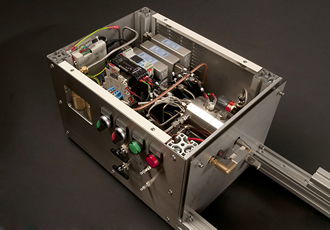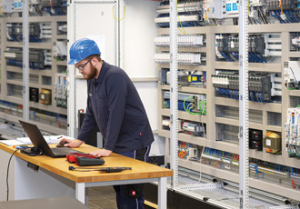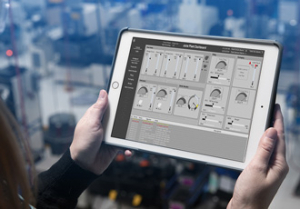Precision gas control for experimental combustion rig

Designing and manufacturing one-off pieces of equipment requires considerable engineering skill, especially when that equipment is required to control combustible gases and deliver precisely repeatable results. So when Saflame was approached to design an experimental combustion rig which required precise, independent control of three gases, it turned to Bürkert Fluid Control Systems to provide the solution.
Saflame is a manufacturer and supplier of thermal processing and control equipment to a wide range of industries and has considerable expertise in designing the control mechanisms including the use of PLC's, SCADA and fieldbus systems. This experience led to a request from the Chemistry Department at the University of Liverpool for Saflame to develop a special laboratory combustion rig to assist with research into flame deposition of chemical films onto various materials.
The design process started with the initial consultation where the university provided an outline of the purpose of the rig, the gases involved and the limiting factor of size which was determined by the dimensions of the fume cupboard in which the test rig would be operating. Beyond this basic list of parameters, the detailed design was left in the hands of the engineers at Saflame.
Three major design areas were established first, safety, precision and connectivity. The first was of paramount importance and is a constant feature in any Saflame design, while connectivity was also a long-standing element of its control panels. The level of gas control which would be required in this particular project needed some expert assistance, which was provided by Bürkert.
The basic concept of the combustion rig was provide a platform which would allow oxygen, nitrogen and liquefied petroleum gas (LPG) to be mixed at precise ratios and ignited to produce a consistent flame. Once a stable flame is established, a test chemical is introduced into this flame and then deposited onto a sample material plate which is positioned in front of the flame.
Once the design specification had been finalised with the university, the project needed to become a reality which meant sourcing all of the components to build the rig and making sure that the finished product would deliver the precision required for scientific research data. Saflame approached Bürkert with the specifications for the gas control system and following the consultation, Bürkert suggested the Type 8713 mass flow controller (MFC) for gases, which was ideally suited to this project.
The Type 8713 is a compact device which is designed to provide precise and consistent results, based on Bürkert's 60 years of experience in measuring, controlling and regulating fluids. It uses CMOSens® technology to accurately measure the gas flow rate allowing it to control a set point or actual value changes within 100ms and also maintain its high sensitivity, even at low flow rates.
Three Type 8713 MFC's, one for each gas, were incorporated into the design and connected to the GRX SCADA system, which allowed each MFC to be independently programmed, controlled and monitored during each experiment.
Gary Williams, Technical Director at Saflame, comments: "There were a number of design hurdles that needed to be overcome but thankfully flow control for the gases was easy to solve. The support from Bürkert was excellent which meant that our design team could spend more time on the other aspects of the project.
"The Bürkert product really was a plug & play item with its connectivity allowing direct control through our GRX SCADA system, which allows the parameters of each experiment to be recorded and replicated if necessary. The MFC's proved to be easy to set up and following some commissioning and training with the university, the combustion rig has been performing perfectly."
Dr Troy Manning, who gave the initial design specification to Saflame, commented "We have worked closely with Saflame to ensure that the finished rig would fulfil our requirements. As part of a research project, it is crucial that we can record all of our base data and also repeat experiments with a level of precision that allows meaningful, reproducible results to be collected."
Similar articles
More from Burkert Fluid Control Systems
- Continuous water quality analysis for boreholes 6th July 2020
- Controller delivers precision microlitre dosing 14th May 2020
- Multi-medium testing facility for fluidic components 19th March 2020
- Micro precision for time-pressure dosing 10th December 2019




 technology at Jacobs Vehicle Systems.JPG)







Write a comment
No comments